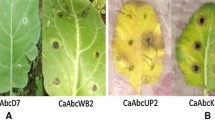Abstract
Isolates of Verticillium dahliae were collected from affected woody ornamentals in German tree nurseries. Nitrat non-utilizing mutants were produced and vegetative compatibility groups (VCGs) were identified based on complementation tests. The results of this study indicate that VCG diversity of V. dahliae in German is limited, because only two VCGs were detected. Of the 32 isolates analysed, 19 were classified as VCG D1 and 13 as VCG D2. VCG D1 was compatible with the American VCG 2B, whereas VCG D2 was compatible with VCG 4B. In morphological studies a significant correlation between the conidial length of the V. dahliae isolates and their VCG could be detected. Isolates from VCG D1 consistently formed small conidia with an average length of 3,78:gmm, whereas isolates from VCG D2 produced larger conidia with an average length of 4,36:gmm. Pathogenicity tests were carried out with isolates on Acer platanoides, Acer pseudoplatanus, Catalpa bignonioides, Castanea sativa, Fraxinus excelsior and Tilia cordata. The isolates showed little significant differences in their aggressiveness to certain hosts. No major differences in virulence between VCGs were observed. The results imply that VCG identification does not contribute to verticillium disease prediction for a range of woody hosts.
Zusammenfassung
Von befallenen Ziergehölzen aus Baumschulen unterschied-licher Anbaugebiete wurden Isolate von Verticillium dahliae gewonnen. Mittels der Herstellung von nit-Mutanten und der Durchführung von Komplementationstests wurden zwei vegetative Kompatibilitätsgruppen (VCG) innerhalb der Isolate identifiziert. Von den 32 untersuchten Isolaten konnten 19 der VCG D1 und 13 der VCG D2 zugeordnet werden. Die Gruppen erwiesen sich mit den amerikanischen VCGs 2B bzw. 4B kompatibel. In morphologischen Untersuchungen konnte eine signifikante Korrelation zwischen der Konidien-länge der Isolate und ihrer VCG festgestellt werden. Isolate der VCG D1 bildeten Konidien mit einer durchschnittlichen Länge von 3,78:gmm aus, während Isolate der VCG D2 Konidien mit einer Länge von 4,36:gmm produzierten. Mit den Isolaten wurden Pathogenitätests an Acer platanoides, Acer pseudoplatanus, Catalpa bignonioides, Castanea sativa, Fraxinus excelsior und Tilia cordata durchgeführt. Die Isolate wiesen hierbei nur geringe signifikante Unterschiede in ihrer Virulenz gegenüber einer Wirtspflanze auf. Auch zwischen den beiden Kompatibilitätsgruppen konnten keine relevanten Virulenzunterschiede festgestellt werden. Die Ergebnisse zeigen, dass eine VCG-Bestimmung im Rahmen der Verticillium-Prognose bei einer Reihe betroffener Ziergehölze nicht erforderlich ist.
Similar content being viewed by others
References
Barbara, D.J., E.J. Paplomatas, R.M. Jimenez-Diaz, 1998: Variability in V. dahliae. In: J.A. Hiemstra, D.C. Harris (eds.): A Compendium of Verticillium Wilts in Tree Species, pp. 43–47. CPRO-DLO, Wageningen, The Netherlands/HRI-East Malling, West Malling, UK.
Chandelier, A., F. Laurent, D. Dantinne, L. Mariage, M. Etienne, M. Cavelier, 2003: Genetic and molecular characterization of Verticillium dahliae isolates from woody ornamentals in Belgian nurseries. Eur. J. Plant Pathol. 109, 943–952.
Chen, W., 1994: Vegetative compatibility groups of Verticillium dahliae from ornamental woody plants. Phytopathology 84, 214–219.
Daayf, F., M. Nicole, J.P. Geiger, 1995: Differentiation of Verticillium dahliae populations on the basis of vegetative compatibility and pathogenicity on cotton. Eur. J. Plant Pathol. 101, 69–79.
Elena, K., E.J. Paplomatas, 1998: Vegetative compatibility groups within Verticillium dahliae isolates from different hosts in Greece. Plant Pathol. 47, 635–640.
Elena, K., 2000: Vegetative compatibility among Verticillium dahliae isolates from watermelon in Greece. Phytoparasitica 28, 115–120.
Goud, J.C., A.J. Termorshuizen, 2002: Pathogenicity and virulence of the two Dutch VCGs of Verticillium dahliae to woody ornamentals. Eur. J. Plant Pathol. 108, 771–782.
Goud, J.C., 2003: Verticillium wilt in trees. Detection, prediction and disease managment. PhD thesis, Wageningen Universiteit, Wageningen, The Netherlands.
Hawksworth, D.L., P.W. Talboys, 1970: Verticillium dahliae. C.M.I. Descriptions of Pathogenic Fungi and Bacteria, No. 256. CABI Publishing, Wallingford, UK.
Harris, D.C., J.R. Yang, 1995: Characteristics of English isolates of Verticillium dahliae. Phytoparasitica 23, 42.
Harris, D.C., J.R. Yang, 1996: The relationship between the amount of Verticillium dahliae in soil and the incidence of strawberry wilt as a basis for disease risk prediction. Plant Pathol. 45, 106–114.
Harris, D.C., 1998: An introduction to verticillium wilts. In: J.A. Hiemstra, D.C. Harris (eds.): A Compendium of Verticillium Wilts in Tree Species, pp. 1–4. CPRO-DLO, Wageningen, The Netherlands/HRI-East Malling, West Malling, UK.
Heale, J.B., 1988: Verticillium spp., the cause of vascular wilts in many species. Adv. Plant Pathol. 6, 291–312.
Hiemstra, J.A., 1998: Some general features of Verticillium wilts in trees. In: J.A. Hiemstra, D.C. Harris (eds.): A Compendium of Verticillium Wilts in Tree Species, pp. 5–11. CPRO-DLO, Wageningen, The Netherlands/HRI-East Malling, West Malling, UK.
Hiemstra, J.A., M. Rataj-Guranowska, 2003: Vegetative compatibility groups in Verticillium dahliae isolates from the Netherlands as compared to VCG diversity in Europe and in the USA. Eur. J. Plant Pathol. 109, 827–839.
Joaquim, T.R., R.C. Rowe, 1990: Reassessment of vegetative compatibility relationships among strains of Verticillium dahliae using nitrate-nonutilizing mutants. Phytopathology 80, 1160–1166.
Joaquim, T.R., R.C. Rowe, 1991: Vegetative compatibility of strains of Verticillium dahliae from soil and potato plants. Phytopathology 81, 552–558.
Karapapa, V.K., B.W. Bainbridge, J.B. Heale, 1997: Morphological and molecular characterization of Verticillium long-isporum comb. Nov., pathogenic to oilseed rape. Mycol. Res. 101, 1281–1293.
Korolev, N., R.M. Jimenez-Diaz, J. Katan, T. Katan, 1998: Vegetative compatibility and pathogenicity of Verticillium dahliae cotton isolates from Spain and Israel. Phytoparasitica 26, 2.
Korolev, N., J. Katan, T. Katan, 2000: Vegetative compatibility groups of Verticillium dahliae and their regional distribution in Israel. In: E.C. Tjamos, R.C. Rowe, J.B. Heale, D.R. Fravel (eds.): Advances in Verticillium Research and Disease Management, pp. 78–91. APS Press, St. Paul, MN, USA.
Nicot, P.C., D.I. Rouse, 1987: Relationship between soil inoculum density of Verticillium dahliae and systemic colonization of potato stems in commercial fields over time. Phytopathology 77, 1346–1355.
Paplomatas, E.J., D.M Bassett, J.C. Broome, J.E. DeVay, 1992: Incidence of Verticillium wilt and yield losses of cotton cultivars (Gossypium hirsutum) based on soil inoculum density of Verticillium dahliae. Phytopathology 82, 1417–1420.
Rowe, R.C., D.A. Johnson, M.A. Omer, 2000: Vegetative compatibility analysis of strains of Verticillium dahliae from potato seed tubers and plants from western and eastern North America. In: E.C. Tjamos, R.C. Rowe, J.B. Heale, D.R. Fravel (eds.): Advances in Verticillium Research and Disease Management, pp. 95–99. APS Press, St. Paul, MN, USA.
Sinclair, W.A., K.L. Smith, A.O. Larsen, 1981: Verticillium wilt of maples: symptoms related to movement of the pathogen in stems. Phytopathology 71, 340–345.
Shigo, A.L., 1984: Compartmentalization: a conceptual framework for understanding how trees grow and defend themselves. Annu. Rev. Phytopathol. 22, 189–214.
Smith, L.D., D. Neely, 1979: Relative susceptibility of tree species to Verticillium dahliae. Plant Dis. Rep. 34, 26–27.
Strausbaugh, C.A., 1993: Assessment of vegetative compatibility and virulence of Verticillium dahliae isolates from Idaho potatoes and tester strains. Phytopathology 83, 1253–1258.
Subbararo, K.V., T.R. Chassot, J.C. Gordon, J.C. Hubbard, P. Bonello, R. Mullin, D. Okamato, R.M. Davis, S.T. Koike, 1995: Genetic relationships and cross pathogenicities of Verticillium dahliae isolates from cauliflower and other crops. Phytopathology 85, 110 5–1112.
Termorshuizen, A.J., J.R. Davis, D.C. Harris, G. Huisman, G. Lazarovits, T. Locke, J.M. Melero Vara, L. Mol, E.J. Paplomatas, H.W. Platt, M. Powelson, D.I. Rouse, R.C. Rowe, L. Tsor, 1998: Interlaboratory comparison of methods to quantify microsclerotia of Verticillium dahliae in soil. Appl. Environ. Microbiol. 64, 3846–3853.
Zeise, K., A. von Tiedemann, 2001: Morphological and physiological differentiation among vegetative compatibility groups of Verticillium dahliae in relation to V. longisporum. J. Phytopathol. 149, 469–475.
Zeise, K., A. von Tiedemann, 2002: Host specialization among vegetative compatibility groups of Verticillium dahliae in relation of Verticillium longisporum. J. Phytopathol. 150, 112–119.
Author information
Authors and Affiliations
Corresponding author
Rights and permissions
About this article
Cite this article
Neubauer, C., Heitmann, B. & Vogel, C. Morphology, vegetative compatibility and pathogenicity of Verticillium dahliae isolates from woody ornamentals in Germany. J Plant Dis Prot 116, 109–114 (2009). https://doi.org/10.1007/BF03356295
Received:
Accepted:
Published:
Issue Date:
DOI: https://doi.org/10.1007/BF03356295




